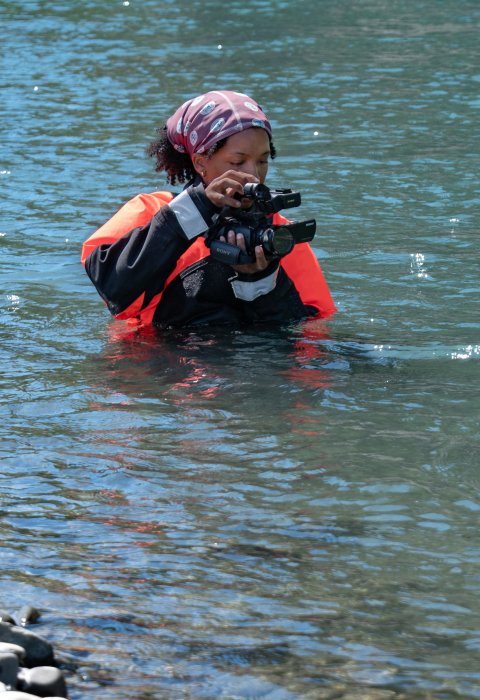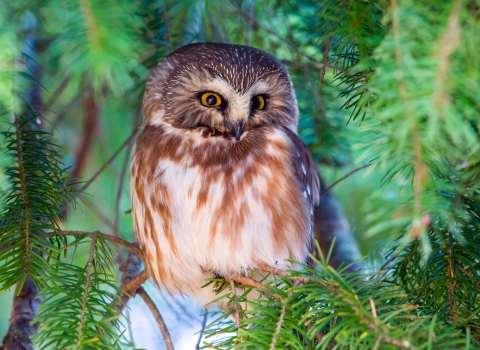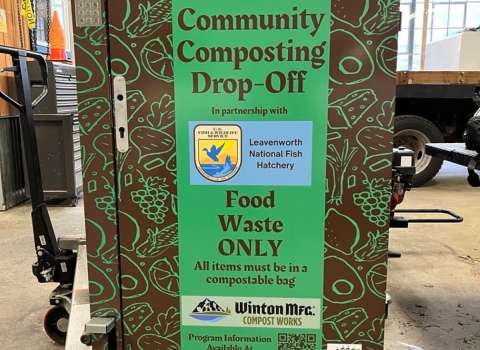As a young girl, Typhanie Shepherd was enamored with a charismatic lemur named Jovian on the wildlife show Zoboomafoo. Growing up, she continued to feed her curiosity by watching Discovery Channel, Science Channel, and MythBusters, all of which shaped her interest in wildlife and science. She was captivated by the imagery, but the thing she wanted to know most was how were these shows being filmed? How were they getting these incredible shots?
This curiosity and interest in science and documentaries became embedded in her mind. She wanted to know how they did it – and more than anything, she wanted to do it herself.
Shepherd’s father, a talented technician and artist in his own right, was her greatest advocate toward exploring her interests. “My dad has always pushed me to go forward with my art. He inspired me to continue to create no matter what it was.”
His sage words still resonate with her today: “If you can see it in your head, you can hold it in your hands.”
Throughout her life, her father’s message propelled her to pursue her vision. “If I can envision it, there is a 100% chance that I can obtain it,” she says. “The chances are always low at some point, but they are never zero. My dad is absolutely the reason why I am where I am today.”
With her insatiable curiosity, father’s wisdom, and belief in her vision as a solid foundation, Shepherd went to college to major in filmmaking with an emphasis in documentary film and a minor in sculpture at Stephen F. Austin State University in Nacogdoches, Texas.
Post graduation, she was determined to find the job that she imagined in her mind as a child – harnessing the power of imagery to make films that educate and inspire wonder and curiosity of the natural world. At that time, she was not aware the U.S. Fish and Wildlife Service even existed.
Shepherd spent late nights searching the internet for potential opportunities. She reached out to anyone she could find that worked in the outdoor film industry. In her exploration, she found the name and email address of an audiovisual production specialist for the National Park Service. She took a chance and sent him an email at 2 a.m.
To Shepherd’s surprise she received a response a few days later, and they coordinated to have a call. In a 15-minute conversation, the production specialist told Shepherd to pursue her passion. He advised her to “create what you want to see in the world.”
Shepherd already had the creative drive, and this only fueled it. It was all she needed to hear. “A 15-minute conversation completely changed my life,” she says.
“That moment taught me to continue to persist. If you feel like you are in a rut and you don't know where to go or who to talk to, just keep moving, keep moving forward, keep reaching out, keep networking, because at some point someone’s going to see you and say, ‘All right, yeah, I got 15 minutes.’”
After that conversation, Shepherd launched herself into searching for jobs that fit her vision. She landed on another college’s workforce webpage and found an internship position for filming in the outdoors of western Washington. She saw that they needed a digital media intern and field crew member. This was perfect.
Shepherd landed the job, and it was during this internship when she was introduced to the Service. She served in a 7-month AmeriCorps internship through a partnership with the American Conservation Experience at the Western Washington Fish and Wildlife Conservation Office with the Pacific Region’s Fish and Aquatic Conservation Program.
In this role, Shepherd floated and filmed fish surveys along the Elwha River with Service and Tribal biologists, she worked with a 4H camp to help stock rainbow and cutthroat trout for outreach fishing opportunities for kids, she filmed fish surveys and tagging on the Dungeness River on the Olympic Peninsula. She also made a short film and interview with Suzena Arias who was interning through the Minorities in Agriculture Natural Resources and Related Sciences chapter at Washington State University and the Hispanic Access Foundation; this was an incredible piece to highlight internship opportunities and continue bringing great people to the program.
Shepherd also interned with the Portland-Vancouver Urban Refuge Program where she took footage of the accessibility of trails and created outreach materials for Tualatin River, Steigerwald Lake, Wapato Lake, and Ridgefield National Wildlife Refuges to promote more accessible opportunities for visitors.
Shepherd was living her vision and doing the work that she and others believed she could do – to educate and inspire wonder and curiosity of the natural world through digital media.
After her internships, Shepherd’s vision continued to manifest. She became a permanent employee with the Pacific Region’s Office of Communications in 2023 as a public affairs specialist and videographer. In the short time she’s been in this role, she’s chased biologists in conducting rapid response genetics work with bull trout along the Yakima River and has looked eye-to-eye with Pacific Lamprey at Abernathy Fish Technology Center. She was also key in creating the “Living the Wild Dream” project to document the incredible career journeys of five employees in the Pacific Region, herself included.
Shepherd reflects on her first internship with the Fish and Aquatic Conservation Program and shares about Judy Gordon, the inspiration behind the Living the Wild Dream project and the assistant regional director for the program with 40 years of federal service under her belt. Recognizing their effectiveness, Gordon is a strong promoter of the continued internship opportunities in her program such as the one that launched Shepherd into her career.
“Judy is a role model,” says Shepherd. “She is someone I absolutely look up to. And I dream that at some point I can sit down with her and share all the moments that I have experienced working with fisheries with her, and let her know that the work that she does is phenomenal.”
Shepherd says the greatest challenge along her journey was finding the exact role she would fill within the Service. Now that she’s found it, her opportunities to educate through visual storytelling will be boundless.
She is now poised to create the very content that captivated her and so many others as young children, which sparked those first moments of wonder with the natural world. She is producing the visual vehicles to illustrate the species, landscapes, and people behind the Service’s conservation mission.
For anyone who finds themselves in a similar situation – right out of college or looking for which direction to go, Shepherd’s wisdom and experiences serves as encouragement and an example of what is possible:
Be persistent: “Through persistence, you can do and become anything you want to be. Keep making. Keep creating.”
The chances are never zero: “If you can see yourself in that position, no matter where you have come from, no matter what your timeline has brought you to – if you can see yourself doing it, there is absolutely a chance.”
You belong: “It doesn't matter who is already in that position. It doesn't matter what they look like, what background they come from. If you feel in your heart of hearts that you belong in that specific position, then you will get there. Don’t question whether or not you belong there. If you’re good at it, you belong there. If you love doing it, you belong there. If you’re passionate about it, you belong there. I take that everywhere I go.”






